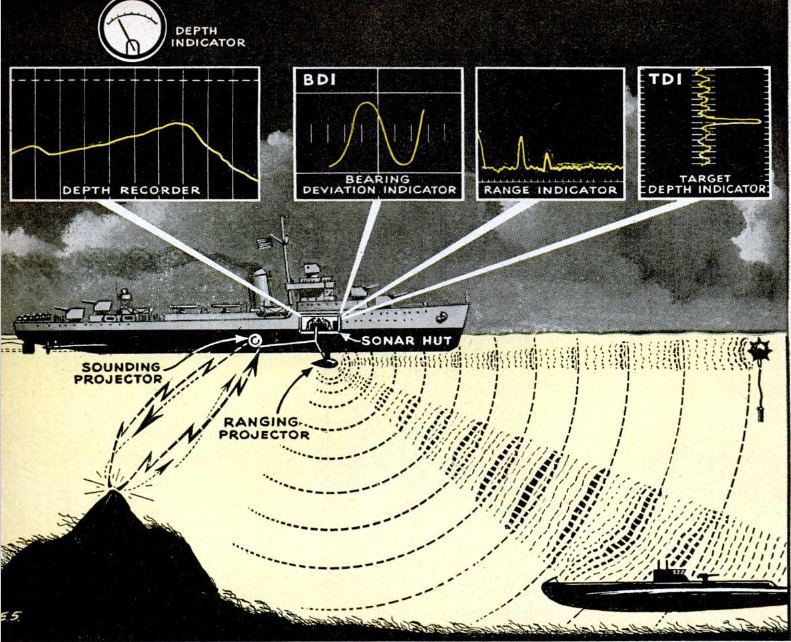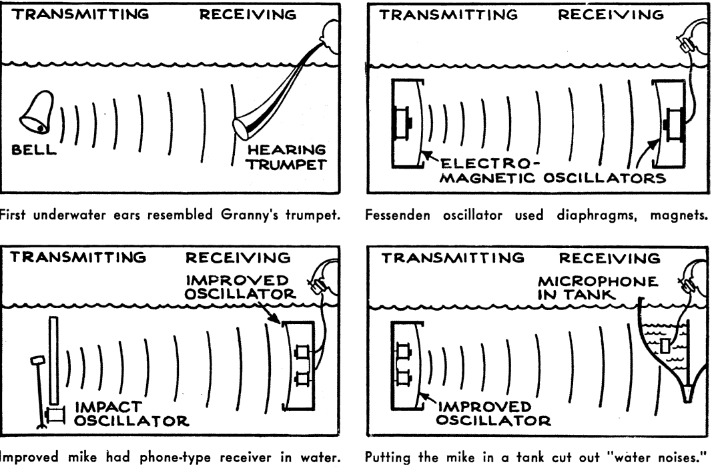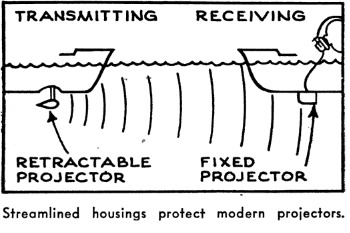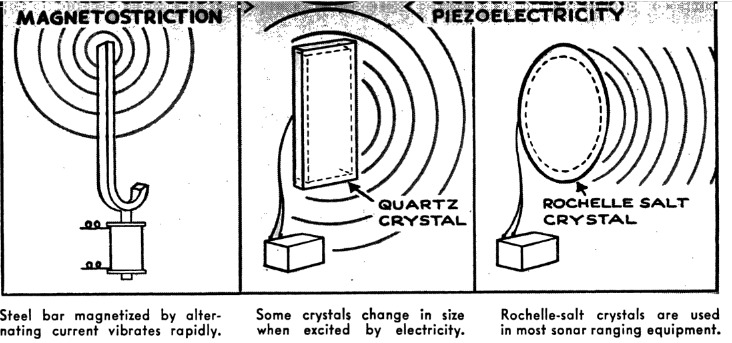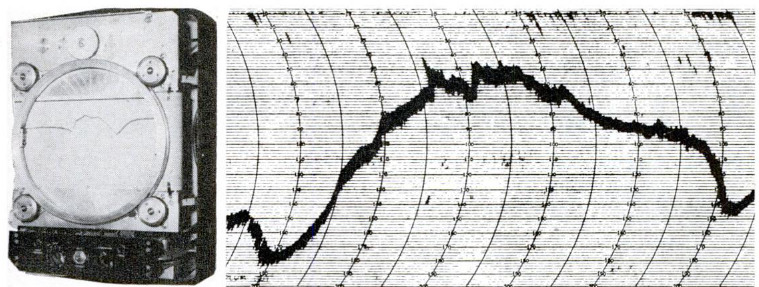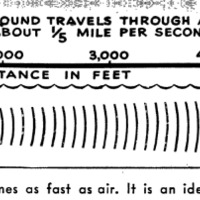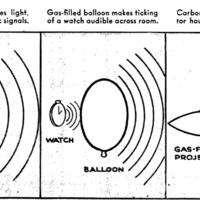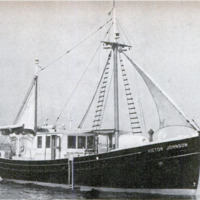-
Title (Dublin Core)
-
The radar of the deep...sonar
-
Article Title and/or Image Caption (Dublin Core)
-
Title: The radar of the deep...sonar
-
extracted text (Extract Text)
-
SECRET eyes and ears installed in the bot-
toms of ships to thwart submarines now
are helping to protect seafarers from perils
of navigation, including the hundreds of
thousands of mines still strewn around the
world. Sonar (submarine detection and
ranging) devices are a new means of both
exploring and exploiting the seven tenths of
the earth's surface that lies beneath the
oceans. They can be used not only by mar-
iners, to avoid reefs, wrecks, and mines,
but also by fishermen and naturalists, to
hear the grunting, purring, croaking, and
drumming of fish.
Sonar includes listening gear, ranging
equipment, and sounding apparatus. In this
“Davy Jones's radar,” high-frequency sound
waves are used instead of radio waves. But
electronics and magnetism have been linked
with sonic science to detect and locate ob-
jects below the sea more swiftly and cer-
tainly. Underwater menaces have been lo-
cated miles away, and torpedoes racing at
40 knots or faster toward a ship have been
detected and traced in time for the vessel
to dodge them.
A metallic football on a retractable rod
below a ship, or a bulge in its bottom, suf-
fices as a sonar “antenna.” On most ships,
the other equipment is housed in a small
cabin called the sonar hut, occupied during
the war by men whose lips were sealed for
the sake of security. In a submarine, dupli-
cate instruments may be placed in the con-
ning tower and forward torpedo room, and
sound-wave projectors may be located on
top as well as below the hull. Even if a
landlubber could see the projectors, he
would not be likely to guess how acutely
they hear and interpret echoes in the depths.
The man-made waves emitted and re-
ceived by these new “feelers” figured in the
battles of the Atlantic and the Pacific, but
sonar’s work is far from done. The British
Navy alone laid 260,000 mines during the
war; our submarines, minelayers, and B-29's
turned Asia’s ports into death traps; and
the Japanese set mines adrift in ocean cur-
rents sweeping toward America. Sonar will
lessen the dangers in peacetime from these
and other menaces.
The variety of sonar devices already in
use is startling, and more are being de-
veloped. Engineers are working now on
small, inexpensive equipment for pleasure
boats—and on fish detectors to save the
time of professional fishermen.
Production of a 90-pound electronic depth
recorder for peacetime use is planned im-
mediately by the Marine Division of the
Bendix Aviation Corp. This instrument con-
sists of a signal sender, an echo amplifier,
and a recording mechanism that draws an
irregular purple line on a roll of scaled
paper as the ship sails over the mountains
and canyons below the waves. This makes
it as easy for a mariner to get the lay of the
ocean's floor as it is for him to glance at
the headlines of a newspaper. He merely
looks into a window to see the contour of
the bottom of the sea.
If the ship passes over a wreck, the line
of the graph becomes heavier; if a school
of fish swims below the ship, tiny lines on
the graph reveal their presence. The opera-
tor of this particular apparatus, moreover,
needs no special training to use it to search
for buried treasure, navigate through fog
by following hydrographic charts, or to
locate fishing banks and schools of fish,
When Mark Twain was a Mississippi
steamboat pilot, the boatmen took soundings
by hand and called out “Mark Twain” when
the water was two fathoms deep. This new
sonar device does such work faster, more
accurately, and in deeper water than any
man could do it. When measuring the depth
in fathoms, 48 soundings a minute are taken,
which means that a ship doing 10 knots gets
a reading every 21 feet along its course.
When the depth is being measured in feet,
288 soundings are taken a minute, or every
31 feet by a vessel doing 10 knots.
This will facilitate the commercial use of
the great rivers of Africa, South America,
and other continents, as well as make
navigation of the high seas safer. Develop-
ers of the new supersonic depth recorder
contend that it can be used with hydro-
graphic charts in fog and darkness with
more confidence than a magnetic compass.
Much of the romance may vanish from
fishing, however, for sonar will show new-
comers the location of fishing banks which
have thus far been the closely guarded
secrets of old-time fishing-boat captains.
Devices which cost less than a net are being
made for commercial fishermen now. They
are expected to pay for themselves, not only
by helping to locate fish, but also by dis-
closing the rocks and wrecks on which nets
costing up to $3,500 are often torn.
Experienced ichthyologists, tuning in on
the conversations of fish, now can tell what
varieties of fish are making the noises. But
visual depth recorders, so sensitive that
they indicate the presence of fish and their
favorite haunts, will probably suffice for
commercial fishermen's purposes. Fishing
by the seat of one's pants may soon be as
discredited as flying that way.
Like radar, sonar grew out of a long
series of inventions. Sound travels faster
and farther through water than through air,
and devices to pick up the sounds of sub-
marines were invented before World War IL.
The first underwater ears had thin dia-
phragms stretched across openings, like
old-fashioned speaking trumpets. Under-
water bell buoys and oscillators were de-
veloped as warning and communication de-
vices. Receivers were improved and placed
in tanks within ships to reduce undesirable
water noises. Ordinary sounds gave way to
supersonic vibrations, beyond the range of
the human ear, and sonar communication
methods were so improved during this war
that ships could converse by sonar when it
would have been dangerous to use radio.
‘Whether sonar is being used for signal-
ing, or to listen for objects beneath the wa-
ter, or to detect them by emitting waves
which bounce back and are timed like radar
waves, the signals can be made either au-
dible or visible. When desired, sonar can
be set to ring a buzzer or flash a light when
a ship approaches shallow water.
One sonar device has a sonic lens to mag-
nify the sounds or echoes detected. Any
change in the composition or temperature
of a medium conducting sound changes the
velocity of the
sound. In the schoolroom, a balloon full of
gas is sometimes used to demonstrate this.
A watch held against the balloon can be
heard ticking far away. In sonar equipment,
a chamber filled with carbon dioxide gas, or
a vessel full of special oil having the right
acoustic properties, may be used to intensify
the sounds picked up.
Use of sonar was limited for a time by
troubles resulting from changes in the tem-
perature and density of sea water. Warm
and cold layers, such as you have encoun-
tered when swimming, refract sound waves.
Submarines could hide in sonar “blind
spots.” But now, allowance for the deflec-
tions can be made when the temperature
gradient is known. A device called a bathy-
thermograph is used to obtain this infor-
mation. It is a combination thermometer
and depth indicator. One type of bathy-
thermograph is used for close-to-the-surface
recordings and another for deep readings,
‘where much greater pressure is encountered.
Although the employment of high-fre-
quency sounds is a recent development, and
much research remains to be done, the idea
is old. Super-sounds may be produced by
either magnetostriction or “plezoelectrici-
ty,” and use has been made of both methods.
Magnetostriction transmitters are based
on the discovery that certain magnetic ma-
terials are bent rapidly back and forth when
magnetized by alternating-current electric-
ity. A steel bar, for example, can be made
to vibrate at such speed that it will produce
almost pure tones; the sound waves emitted
in some sonar devices are created in this way.
Pierre Curie (later to win fame as a dis-
coverer of radium) discovered piezoelectric
ity in 1880, when he found that certain
mineral crystals change in thickness and
length when excited by electrical currents.
Conversely, when pieces of crystal are vi-
brated by mechanical means, charges of
static electricity are developed on their sur-
faces. These crystals have a certain grain,
or electrical axis. When they are properly
cut into disks or rods, they vibrate, or oscil-
late, uniformly. Hence, crystals can be used
as “valves” to stabilize radio and radar-
tuning frequencies. Quartz is used in most
electronic applications, while Rochelle salt
is employed in most sonar ranging equip-
ment.
Sound waves set up by magnetostriction
or plezoelectricity can be directed like rays
from a searchlight and projected through
the cold, dark waters of the sea for miles.
Some of the sonar ranging devices used by
the Navy to detect targets will reveal the
presence of certain objects at distances
greater than six miles.
The use of supersonic rather than sonic
vibrations makes it possible to control the
direction and concentration of the waves
emitted with much greater accuracy, and
to eliminate side echoes and extraneous
noises such as those from waves and other
ships which might mislead the sonar opera-
tors. The new eyes and ears of ships, more-
over, do their jobs as silently as those of
people.
Navy rangers have cathode-ray BDI
(bearing direction indicator) scopes which
tell the operator the direction of the object
detected. Another indicator called the MTB
(maintenance of true bearing) may be at-
tached to both the projector and the ship's
gyro compass. When this “target holder” is
engaged, it keeps the sonar ranging pro-
jector trained on the target regardless of
the ship's maneuvers.
Another interesting device that can be
hooked to the ranging set is the AP (at-
tack plotter). It has a special circular
scope, similar to one type of radar scope,
which provides a running account of a
whole battle that may be raging around a
ship beneath the surface. It was particu-
larly valuable against Nazi wolf packs and
Jap suicide craft.
Sonar has even been combined with radar
to produce robots called sono buoys. These
were planted in harbors, channels, and other
waters to watch for submarines. Each buoy
consisted of a small, floating radar beacon
with an underwater microphone. When the
vibrations of a submarine’s propeller were
heard by this microphone, the radar trans-
mitter was started. Each buoy was set so
as to emit a distinctive signal. Planes and
destroyers can move so much faster than a
submarine that it often was possible to re-
spond to these cries of alarm from sono
buoys and drop depth charges before the
submarine got away.
One time off Scotland, the sonar story-
tellers insist, a lighthouse equipped with
underwater listening devices located a sub-
merged U-boat and called up forces to sur-
round it. Divers went down to tap on the
side and tell the occupants in Morse code
that they could either come up and sur-
render or be depth-bombed. The submarine
crew tapped back that they'd come right
up—and did.
-
Contributor (Dublin Core)
-
James L. H. Peck (article writer)
-
Language (Dublin Core)
-
Eng
-
Date Issued (Dublin Core)
-
1945-11
-
pages (Bibliographic Ontology)
-
84-87,246,250
-
Rights (Dublin Core)
-
Public domain
-
Archived by (Dublin Core)
-
Sami Akbiyik
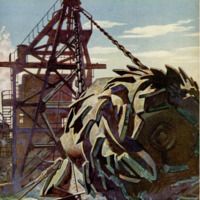 Popular Science Monthly, v. 147, n. 5, 1945
Popular Science Monthly, v. 147, n. 5, 1945

